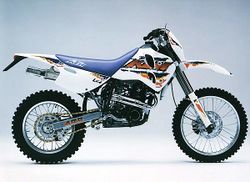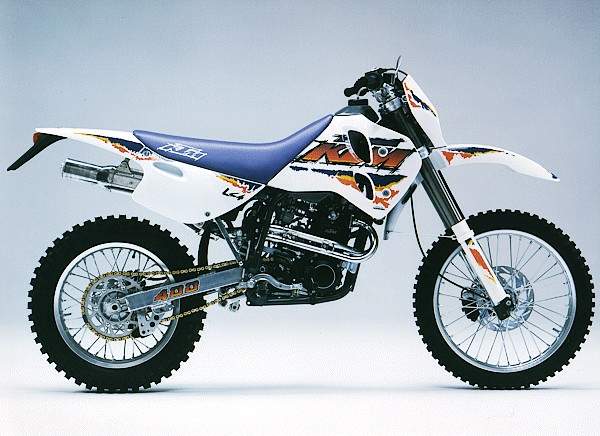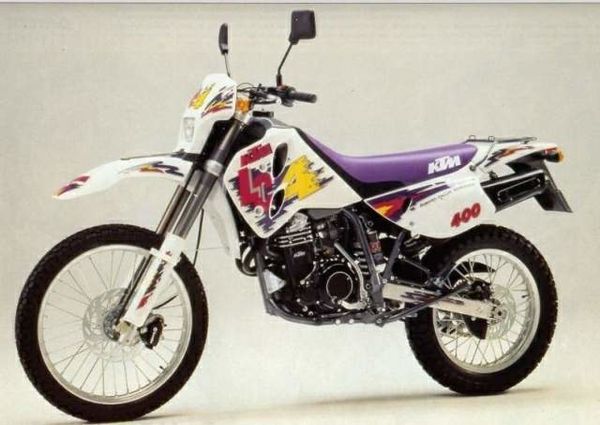KTM 400 LC4 EGS
 |
|
| KTM EGS400 | |
| Manufacturer | |
|---|---|
| Also called | 400 LC4 EGS-E, 400 LC4 EGS, 400 EGS-E, 400 EGS |
| Production | 1994 - 96 |
| Engine | Four stroke, single cylinder |
| Top Speed | 155 km/h / 96.3 mph |
| Transmission | 5 Speed |
| Suspension | Front: 43 mm Upside-down fork Rear: WP monoshock, rebound and compression adjustment |
| Brakes | Front: Single disc Rear: Single disc |
| Seat Height | 940 mm / 37 in |
| Weight | 137 kg / 302 lbs (dry), |
| Fuel Capacity | 8.5 L / 2.2 US gal / 1.9 Imp gal |
| Manuals | Service Manual |
It could reach a top speed of 155 km/h / 96.3 mph.
Engine[edit | edit source]
The engine was a Liquid cooled cooled Four stroke, single cylinder.
Chassis[edit | edit source]
Stopping was achieved via Single disc in the front and a Single disc in the rear. The front suspension was a 43 mm Upside-down fork while the rear was equipped with a WP monoshock, rebound and compression adjustment. The 400 LC4 EGS was fitted with a 8.5 L / 2.2 US gal / 1.9 Imp gal fuel tank. The bike weighed just 137 kg / 302 lbs.
Photos[edit | edit source]
Overview[edit | edit source]
KTM 400 LC4 EGS
Dirt Rider review 1995
Fire roads and big four-strokes
are a recipe for'big tun with any rider on board. Assign the inside line to
KTM off-road hero Scot Harden on a-KTM 620 LC4 R/XC and tell two-time
Houston National TT winner John Hate-ley to go wide on the 400 R/XC, and
things really get wild! The beauty of KTM's new R/XCs is that they work even
better on the trail than they do on the road!
KTM continues to amaze us. This
innovative European company takes chances while the Japanese manufacturers
make conservative moves. KTM often equaled or beat the Japanese with
technological advances like liquid-cooled 125cc motocrossers, disc brakes,
digital ignitions and inverted forks on production bikes.
And now KTM has done it again
with the first race-ready dual-purpose machines: the 400 and 620 LC4 R/XC,
street-legal versions of the E/XC competition enduro machines.
In the past, dirt riders who've encountered sections of public highway
between trails have had three equally unpleasant choices: be an outlaw and
take a chance; convert an off-road bike to a pseudo-legal,
don't-look-too-close EPA renegade; or put up with factory dual-purpose
machines that feel light and nimble on asphalt but ride like ugly-handling,
underdamped street bikes in the dirt.
Recent years have seen some
improvement in factory offerings, but even the Honda XR-L and the stock
Suzuki DR-S models are comfortable only on undemanding dirt surfaces at a
fairly casual pace. Infusions of time, money and aftermarket products help
make them dirt worthy, but dirt riders want a stock machine that can be
ridden to an off-road race then raced competitively. Few riders do that, but
the possibility gives you trail confidence.
KTM's new 400 and 620 R/XCs are
closer to race-ready street-legal machines than anything we've seen in
decades. Their entire effort was aimed at making the race-quality 400 and
620 E/XC models road legal. The result is a pair of machines that we would
actually consider racing. You don't have to scratch the skin of the R/XCs
too deeply to get the E/XCs to shine through, and that's what Dirt Rider
expects of a dual-purpose machine. These are real off-road racers with the
bare necessities of legality attached.
LOOK OUT, IT'S THE FEDS
To get their LC4
E/XCs street-legal KTM had to deal with several government entities and
standards.
KTM uses a two-stroke-type crankshaft with crank seals for their
four-strokes like Husq-varna or Husaberg, but KTM also uses a tiny oil pump
and provides this finned oil micro filter. Those additions and a slightly
greater oil capacity than the LC4 E/XCs should make for a very long-lived
motor.
structed lights, turn signals,
mirrors, rims and tires. Then they had to meet the EPA's noise and emissions
standards. Fortunately, the KTM strokers already meet tough European
standards, so they were able to pass 49 state emissions tests with no sweat,
and they whispered through the 50-foot acceleration test with an 80 dbA
reading. It appears that the KTMs are just a charcoal canister away from
being California emissions-legal. Actual horsepower output didn't suffer
much to meet these standards, but the bikes do require 16/45 (400) or 16/40
(620) gearing to pass.
The 620 E/XC uses a 15/50 combo
and the 400 E/XC uses 14/50, so the R/XCs feel overgeared.
After satisfying the feds, KTM had to satisfy the vehicle codes of all 50
states. That meant a tiny gel battery had to be affixed to the top of the
airbox to run a taillight with the engine off.
So, just how different is an R/XC from an E/XC? In addition to the minimal
lighting and voltage regulator you'll find rubber inserts in the foot-pegs,
a center stand rather than a side-stand, a steel subframe (to make it safe
to carry a passenger), a steel muffler with a spark arrestor, the required
switches, mirrors and an airbox cover. There are DOT-approved D.l.D rims and
Pirelli MT21 tires too. A 400 E/XC weighs 265 pounds, a 620 weighs 266
pounds; the R/XCs weigh 298 wet with no gas. That's the same as Kawasaki's
dirt-only KLX650R.
TEST DRIVE
Once we were done kicking the
tires we wanted to hit the trails. KTM's National Sales Manager, Scot
Harden, was hoping for some pavement or fire roads to begin our ride.
Naturally, we headed for a nasty uphill single-track trail wrinkled with
180-degree switchbacks. We then proceeded onto our standard enduro bike test
loop, and we didn't cut the bikes any slack. With the tall gearing we spent
a lot of time in first and second gears, but only the gearing, tires and
mirrors remind you that you aren't on race-spec enduro machines.
These trails are solid rock in
some places with a shattered surface and many ugly stairsteps as well as
more rain ruts than you ever wanted to see. The R/XCs have the identical
suspension components, spring rates and valving as the E/XCs, but the added
weight of the R/XCs makes them a little plusher, which is good for
dual-sport-type exploring. They soaked up the rocks and ruts exceptionally
well. The suspension action was crisp and controlled, so we felt comfortable
pushing the bikes as hard as the tires would allow. We did experience some
bottoming, so on subsequent rides we upped the shock preload and the
compression damping front and rear with good results.
Power output was quite good for
the most part. The jetting was excellent in the dirt, and both bikes started
easily and ran cleanly. However, the 400 felt docile at low rpm and clearly
suffered from the tall gearing on steep hills; a smaller countershaft
sprocket would help dramatically. Conversely, the 620 R/XC is brutally
powerful. It makes so much bottom boost that we wanted to ride it in second
gear in the tight sections to calm it down. Unfortunately, we kept stalling
until we got the clutch
The rear hub incorporates rubber
cushions to ease shock to the transmission during shifts on pavement. The
smallish rear sprocket is required for the bike to pass sound and emissions
standards but can be changed for off-road use.
We didn't have any comparison bikes along, but the 620 R/XC feels as fast as an XR600R or a KLX650R. It smokes any similarly sized dual-purpose machine. WHAT'S THE DIFFERENCE? The 620 roosts the 400, it weighs virtually the same as the 400, it required less gas at our 50-mile fill-up point, and it's no louder than the 400. This is great news for the big-bore crowd. It's a touch harder to start and a bit easier to stall than the 400, but the disparity is not great. Also, the 620 pushes the front end a little more on fast fire roads and vibrates a bit more on the street. For technical riding areas the 400 is more fun to ride, and we liked the 620 for faster, more open areas. We tend to dual-sport on a lot of single-track trails, so when KTM demanded that we choose just one of the bikes for an extended test, we opted for the 400. We put about 80 miles of hard-core dual-sporting on the 620 and about 300 miles on the 400. We even used the 400 to commute to work and ride on the freeway but only to fill out the test; we don't see these bikes as commuters or tourers. Keep in mind that these are dirt bikes; you just happen to be able to ride them on the street. BITS AND PIECES We tested the KTMs on a super-narrow single track with close, brushy trees. When we took the Honda XR650L and Suzuki DR350S on this loop we ended up with only one mirror, and that was just from brush damage, not crash damage. The KTM mirrors telescope up and down, and the mirror heads spin all the way around, so we never tweaked them. For that matter we never tweaked anything on the bikes. All of the lights and hardware are as tiny and lightweight as the law allows; we never even noticed the turn signals. The same was true of the switches. We know for a fact that these bikes will stand up well to off-roading. For dry, hard terrain we'd probably lever on some different tires, although the standard Pirelli MT21s are as good a traction/wear compromise as you'll find. BANKING SENSE The KTMs are a good value as well. Among the street-legal machines the $5798 KTM 620 R/XCs closest competitor is the $4899 Honda XR650L. To make that bike more off-road worthy it would need new tires, different gearing, suspension modifications and a larger fuel tank. We'd also change the air filter, pegs and handlebar (personal preference). Those mods put the XR-L within $100 of the KTM, and the KTM needs only a countershaft sprocket to be off-road ready. But even after you spent the extra cash on the XR-L it will still be heavy and have poor gearbox spacing and less power than the KTM. The $5698 400's closest competition is the Suzuki DR350S. The DR-S retails for $3999 and requires at least $1000 worth of mods, including suspension upgrades, gearing and a new handlebar before it is an effective off-road machine. The DR-S has competitive engine performance, but a reinforced swingarm and a cartridge-type or inverted fork and better shock would be required to match the KTM's handling, and that makes the Japanese machine quite expensive. It depends on how serious you are about your dual-sporting. If you're a serious trail rider or a racer you are used to the handling performance the KTM offers, and you won't be satisfied with less. With current government regulations, it's unlikely that we will see truly legal dual-purpose machines that are any more dirt-oriented or -capable than these KTM R/XCs. The government not only requires these bikes to be clean and quiet, they require that they stay clean and quiet for at least 9300 miles. KTM's R/XCs have satisfied Uncle Sam, but, most importantly, they satisfied Dirt Rider. DR
| Make Model | KTM 400 LC4 EGS |
|---|---|
| Year | 1994 - 96 |
| Engine Type | Four stroke, single cylinder |
| Displacement | 398 cc / 24.3 cu in |
| Bore X Stroke | 89 x 64 mm |
| Cooling System | Liquid cooled |
| Starting | Kick |
| Max Power | 29.9 kW / 41 hp @ 8500 rpm |
| Transmission | 5 Speed |
| Final Drive | Chain |
| Front Suspension | 43 mm Upside-down fork |
| Front Wheel Travel | 295 mm / 11.6 in |
| Rear Suspension | WP monoshock, rebound and compression adjustment |
| Rear Wheel Travel | 320 mm / 12.6 in |
| Front Brakes | Single disc |
| Rear Brakes | Single disc |
| Seat Height | 940 mm / 37 in |
| Dry Weight | 137 kg / 302 lbs |
| Fuel Capacity | 8.5 L / 2.2 US gal / 1.9 Imp gal |
| Top Speed | 155 km/h / 96.3 mph |

